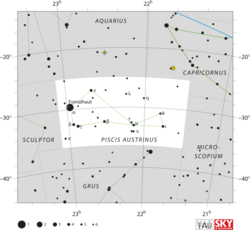Astronomy:Epsilon Piscis Austrini
| Observation data Equinox J2000.0]] (ICRS) | |
|---|---|
| Constellation | Piscis Austrinus |
| Right ascension | 22h 40m 39.34075s[1] |
| Declination | −27° 02′ 37.0157″[1] |
| Apparent magnitude (V) | +4.17[2] |
| Characteristics | |
| Spectral type | B8 Ve[3] or B8 IVe[4] |
| U−B color index | −0.31[2] |
| B−V color index | −0.11[2] |
| Astrometry | |
| Radial velocity (Rv) | +1.1±2.8[5] km/s |
| Proper motion (μ) | RA: +23.22[1] mas/yr Dec.: −0.16[1] mas/yr |
| Parallax (π) | 8.0981 ± 0.3582[6] mas |
| Distance | 400 ± 20 ly (123 ± 5 pc) |
| Absolute magnitude (MV) | −1.66[4] |
| Details | |
| Mass | 4.10±0.19[7] M☉ |
| Radius | 3.2[8] R☉ |
| Luminosity | 661[7] L☉ |
| Surface gravity (log g) | 3.93[9] cgs |
| Temperature | 11,066[7] K |
| Rotational velocity (v sin i) | 216[7] km/s |
| Other designations | |
| Database references | |
| SIMBAD | data |
Epsilon Piscis Austrini, Latinized from ε Piscis Austrini, is a blue-white hued star in the southern constellation of Piscis Austrinus. It is visible to the naked eye with an apparent visual magnitude of +4.17.[2] Based upon an annual parallax shift of 8.0981 ± 0.3582 mas as seen from the GAIA satellite, the system is located roughly 400 light years from the Sun.[6]
This is a B-type main sequence star with a stellar classification of B8 Ve.[3] It is a Be star that is spinning rapidly with a projected rotational velocity of 216 km/s,[7] compared to an equatorial critical velocity of 301 km/s.[9] The star has 4.1 times the mass of the Sun and is radiating 661 times the solar luminosity from its photosphere at an effective temperature of 11,066 K.[7]
Epsilon Piscis Austrini is moving through the Galaxy at a speed of 18.7 km/s relative to the Sun. Its projected Galactic orbit carries it between 23,917 and 28,138 light-years from the center of the Galaxy.[11]
Naming
In Chinese, 羽林軍 (Yǔ Lín Jūn), meaning Palace Guard, refers to an asterism consisting of:
- ε Piscis Austrini
- 29 Aquarii
- 35 Aquarii
- 41 Aquarii
- 47 Aquarii
- 49 Aquarii
- λ Piscis Austrini
- HD 212448
- 21 Piscis Austrini
- 20 Piscis Austrini
- υ Aquarii
- 68 Aquarii
- 66 Aquarii
- 61 Aquarii
- 53 Aquarii
- 50 Aquarii
- 56 Aquarii
- 45 Aquarii
- 58 Aquarii
- 64 Aquarii
- 65 Aquarii
- 70 Aquarii
- 74 Aquarii
- τ2 Aquarii
- τ1 Aquarii
- δ Aquarii
- 77 Aquarii
- 88 Aquarii
- 89 Aquarii
- 86 Aquarii
- 101 Aquarii
- 100 Aquarii
- 99 Aquarii
- 98 Aquarii
- 97 Aquarii
- 94 Aquarii
- ψ3Aquarii
- ψ2Aquarii
- ψ1Aquarii
- 87 Aquarii
- 85 Aquarii
- 83 Aquarii
- χ Aquarii
- ω1 Aquarii
- ω2 Aquarii
Consequently, the Chinese name for ε Piscis Austrini itself is 羽林軍八 (Yǔ Lín Jūn bā, English: the Eighth Sixth Star of Palace Guard.)[12]
References
- ↑ 1.0 1.1 1.2 1.3 van Leeuwen, F. (2007), "Validation of the new Hipparcos reduction", Astronomy and Astrophysics 474 (2): 653–664, doi:10.1051/0004-6361:20078357, Bibcode: 2007A&A...474..653V.
- ↑ 2.0 2.1 2.2 2.3 Feinstein, A.; Marraco, H. G. (November 1979), "The photometric behavior of Be Stars", Astronomical Journal 84: 1713–1725, doi:10.1086/112600, Bibcode: 1979AJ.....84.1713F.
- ↑ 3.0 3.1 Abt, Helmut A.; Levato, Hugo; Grosso, Monica (July 2002), "Rotational Velocities of B Stars", The Astrophysical Journal 573 (1): 359–365, doi:10.1086/340590, Bibcode: 2002ApJ...573..359A.
- ↑ 4.0 4.1 Anderson, E.; Francis, Ch. (2012), "XHIP: An extended hipparcos compilation", Astronomy Letters 38 (5): 331, doi:10.1134/S1063773712050015, Bibcode: 2012AstL...38..331A.
- ↑ Gontcharov, G. A. (November 2006), "Pulkovo Compilation of Radial Velocities for 35495 Hipparcos stars in a common system", Astronomy Letters 32 (11): 759–771, doi:10.1134/S1063773706110065, Bibcode: 2006AstL...32..759G.
- ↑ 6.0 6.1 Brown, A. G. A. (August 2018). "Gaia Data Release 2: Summary of the contents and survey properties". Astronomy & Astrophysics 616: A1. doi:10.1051/0004-6361/201833051. Bibcode: 2018A&A...616A...1G. Gaia DR2 record for this source at VizieR.
- ↑ 7.0 7.1 7.2 7.3 7.4 7.5 Zorec, J.; Royer, F. (2012), "Rotational velocities of A-type stars. IV. Evolution of rotational velocities", Astronomy & Astrophysics 537: A120, doi:10.1051/0004-6361/201117691, Bibcode: 2012A&A...537A.120Z.
- ↑ Pasinetti Fracassini, L. E. et al. (February 2001), "Catalogue of Apparent Diameters and Absolute Radii of Stars (CADARS)", Astronomy and Astrophysics 367: 521–524, doi:10.1051/0004-6361:20000451, Bibcode: 2001A&A...367..521P.
- ↑ 9.0 9.1 Chauville, J. et al. (November 2001), "High and intermediate-resolution spectroscopy of Be stars 4481 lines", Astronomy and Astrophysics 378: 8618–82, doi:10.1051/0004-6361:20011202, Bibcode: 2001A&A...378..861C.
- ↑ "eps PsA -- Be Star", SIMBAD Astronomical Database (Centre de Données astronomiques de Strasbourg), http://simbad.u-strasbg.fr/simbad/sim-id?Ident=eps+PsA, retrieved 2017-05-18.
- ↑ Anderson, E.; Francis, Ch. (2012), "XHIP: An extended hipparcos compilation", Astronomy Letters 38 (5): 331, doi:10.1134/S1063773712050015, Bibcode: 2012AstL...38..331A.
- ↑ (in Chinese) AEEA (Activities of Exhibition and Education in Astronomy) 天文教育資訊網 2006 年 7 月 7 日
 |


